How to install the app on iOS
Follow along with the video below to see how to install our site as a web app on your home screen.

Note: This feature currently requires accessing the site using the built-in Safari browser.
You are using an out of date browser. It may not display this or other websites correctly.
You should upgrade or use an alternative browser.
You should upgrade or use an alternative browser.
Is there any truth to the saying 'bigger the roots, bigger the fruits' when growing cannabis?
- Thread starter Mars_Barz
- Start date
- Joined
- Apr 15, 2023
- Messages
- 1,627
- Reaction score
- 8,348
- Joined
- May 11, 2023
- Messages
- 2,137
- Reaction score
- 9,023
Just to point out a bigger pot doesn’t mean bigger or more roots. You can have much more roots in a 1 gal pot than a 3 gal pot.
IMO growing in the smallest container without becoming rootbound creates the fastest growth if you are able to keep rootzone conditions ideal. This is because of the gas exchange that it enables by frequent fertigation and a larger percentage of the media exposed to air
Bigger buds will be affected by genetics, veg time, PGRs and plant health.
IMO growing in the smallest container without becoming rootbound creates the fastest growth if you are able to keep rootzone conditions ideal. This is because of the gas exchange that it enables by frequent fertigation and a larger percentage of the media exposed to air
Bigger buds will be affected by genetics, veg time, PGRs and plant health.
Rootsruler
Know it all
- Joined
- Apr 14, 2023
- Messages
- 3,273
- Reaction score
- 14,610
So how would you go about setting up the ideal rootzone conditions and how do you keep your roots from getting rootbound in such a small container?Just to point out a bigger pot doesn’t mean bigger or more roots. You can have much more roots in a 1 gal pot than a 3 gal pot.
IMO growing in the smallest container without becoming rootbound creates the fastest growth if you are able to keep rootzone conditions ideal. This is because of the gas exchange that it enables by frequent fertigation and a larger percentage of the media exposed to air
Bigger buds will be affected by genetics, veg time, PGRs and plant health.
Doobie
Blaze Bandit
- Joined
- Jun 13, 2023
- Messages
- 90
- Reaction score
- 334
I use 1 gallon plastic containers. And I fertigate as much as possible. But you can do this with coco. Just don't let the coco dry out completely.So how would you go about setting up the ideal rootzone conditions and how do you keep your roots from getting rootbound in such a small container?
You need to add Mykos and keep the root zone nice and moist but not too moist
Star Dog
Chronic Chemist
- Joined
- Jan 30, 2024
- Messages
- 179
- Reaction score
- 844
Use air pots or fabric pots to prevent root bound they also increases root mass by air prune rootsSo how would you go about setting up the ideal rootzone conditions and how do you keep your roots from getting rootbound in such a small container?

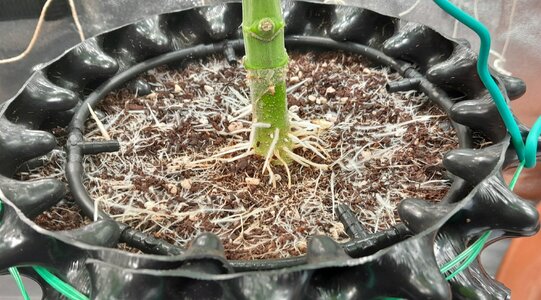
Humidity is bit much in my tent so I stay away from fabric pots but fabric or plastic they both do the same job.
Observer
Quantum Yield Engineer
- Joined
- May 11, 2023
- Messages
- 6,006
- Reaction score
- 14,407
Was gonna say more or less this.Just to point out a bigger pot doesn’t mean bigger or more roots. You can have much more roots in a 1 gal pot than a 3 gal pot.
IMO growing in the smallest container without becoming rootbound creates the fastest growth if you are able to keep rootzone conditions ideal. This is because of the gas exchange that it enables by frequent fertigation and a larger percentage of the media exposed to air
Bigger buds will be affected by genetics, veg time, PGRs and plant health.
Observer
Quantum Yield Engineer
- Joined
- May 11, 2023
- Messages
- 6,006
- Reaction score
- 14,407
Well rootbound isn't really an issue in 1-3gals, 1/2 - 1gallon is really all you need,So how would you go about setting up the ideal rootzone conditions and how do you keep your roots from getting rootbound in such a small container?
or 4inch or 6inch RW blocks.
And
It's basically keeping the same variables you would when watering, like proper E.C/pH, monitoring those and Water Content % would be nice
Checking the run off E.C/pH to see how much the plant is or is not uptaking, subtract the difference and use that e.c/ppm amount, nutrients should be salts, since all it needs to do is dissolve in water with a proper pH and the ions are ready to go, as soon as it hits the roots the plant can uptake.
5.4-5.9pH, 0.1 - 4.0 E.C (up to 8 E.C solution/up to 15 media E.C with some cropsteering fuckery)
DRYBACKS are key.
They start drinking more and more and will just dry up faster and faster, so more fertigation events are required.
If no wc sensor, just lifting the growth container(s) for feel of lightness and plant observation is suffice.
Drippers can shine here tremendously once properly dialed in, and If you can aerate/increase the DO of the fertigation water, bonus points.
Just try a plant in a solo cup, leave it in that it's whole life, eventually you'll notice the patterns and as it grows, the time between needing to fertigate again will Increase.
shot size fertigation events frequently, baseline off the plant showing "water deficiencies" And go from there.
Observer
Quantum Yield Engineer
- Joined
- May 11, 2023
- Messages
- 6,006
- Reaction score
- 14,407
I can get an Oz+ from a solo, and palm/almost fist size tops/colas in solos,half or 1 gallon containers of coco or perlite or vermiculite mixes, or straight cocoTitle.
Should I grow in a bigger pot to get bigger buds? I'm willing and able to stay in veg for extended periods of time allowing the roots to take form if it means I'll harvest bigger buds.
growing in a bigger container won't really change the size of the buds, just take longer, maybe giving me a few more of em, though.
Vegetative and generative crop steering, a near perfect environment, temp,rh,airflow,ppfd co2, nutrients and fertigation schedules, and of course genetics that aren't bunk.
Last edited:
Doobie
Blaze Bandit
- Joined
- Jun 13, 2023
- Messages
- 90
- Reaction score
- 334
I couldn't have said it better. You can almost tell when you are speaking with someone that was taught well by @AquaMan.Well rootbound isn't really an issue in 1-3gals, 1/2 - 1gallon is really all you need,
or 4inch or 6inch RW blocks.
And
It's basically keeping the same variables you would when watering, like proper E.C/pH, monitoring those and Water Content % would be nice
Checking the run off E.C/pH to see how much the plant is or is not uptaking, subtract the difference and use that e.c/ppm amount, nutrients should be salts, since all it needs to do is dissolve in water with a proper pH and the ions are ready to go, as soon as it hits the roots the plant can uptake.
5.4-5.9pH, 0.1 - 4.0 E.C (up to 8 E.C solution/up to 15 media E.C with some cropsteering fuckery)
DRYBACKS are key.
They start drinking more and more and will just dry up faster and faster, so more fertigation events are required.
If no wc sensor, just lifting the growth container(s) for feel of lightness and plant observation is suffice.
Drippers can shine here tremendously once properly dialed in, and If you can aerate/increase the DO of the fertigation water, bonus points.
Just try a plant in a solo cup, leave it in that it's whole life, eventually you'll notice the patterns and as it grows, the time between needing to fertigate again will Increase.
shot size fertigation events frequently, baseline off the plant showing "water deficiencies" And go from there.
Zen_seeker
Kush Kingpin
- Joined
- Apr 16, 2023
- Messages
- 3,421
- Reaction score
- 13,900
That was with those fabric pots too.i think they work much better in your instance than a normal pot…air pruning those roots.
Agreed.
Strain matters too. The Strawberry Lemonade I’m growing in a 1G soft pot has many roots sticking out even though it has the least amount of foliage. It’s a slow grower but very aggressive roots.
Most have browned out this week but they come back and repeat. All the specs and dot are roots not dirt.
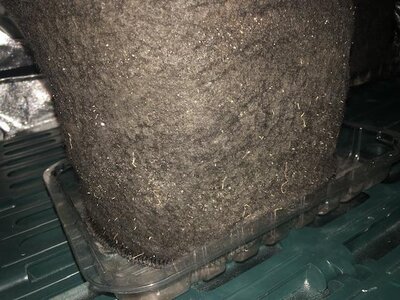
Last edited:
Rootsruler
Know it all
- Joined
- Apr 14, 2023
- Messages
- 3,273
- Reaction score
- 14,610
So essentially I would need to monitor the difference in input vs output ppm? I already feed using ppm so I'll stick with that. Calculate what they took up and base my next PPM feed on those parameters? Is there a start PPM or do I just start with what I normally start with and adjust as the output readings dictate eventually equaling out to feeding whatever they are taking up? How many feed events a day should I expect? How do I monitor the proper soil moisture content? I would imagine with a more experienced grower you can determine through plant response but how do you dial in the soil moisture though a drip system and still get the necessary drybacks? AFAIU, dryback period is to allow the roots to do the proper O2 exchanges it needs before it sucks up all the water in the media. When we initially water the roots slow down the O2 exchanges until the moisture level in the soil reaches a point that o2 exchanges can happen at a more accelerated rate then when they are immersed in water? Do I have the drip sessions go on for a few hours to properly moisten the media to the desired moisture level then turn off the session for the dryback then restart on the day they want more? Sounds like I'll need to keep adjusting the feed schedule according to their growth stage uptake.Well rootbound isn't really an issue in 1-3gals, 1/2 - 1gallon is really all you need,
or 4inch or 6inch RW blocks.
And
It's basically keeping the same variables you would when watering, like proper E.C/pH, monitoring those and Water Content % would be nice
Checking the run off E.C/pH to see how much the plant is or is not uptaking, subtract the difference and use that e.c/ppm amount, nutrients should be salts, since all it needs to do is dissolve in water with a proper pH and the ions are ready to go, as soon as it hits the roots the plant can uptake.
5.4-5.9pH, 0.1 - 4.0 E.C (up to 8 E.C solution/up to 15 media E.C with some cropsteering fuckery)
DRYBACKS are key.
They start drinking more and more and will just dry up faster and faster, so more fertigation events are required.
If no wc sensor, just lifting the growth container(s) for feel of lightness and plant observation is suffice.
Drippers can shine here tremendously once properly dialed in, and If you can aerate/increase the DO of the fertigation water, bonus points.
Just try a plant in a solo cup, leave it in that it's whole life, eventually you'll notice the patterns and as it grows, the time between needing to fertigate again will Increase.
shot size fertigation events frequently, baseline off the plant showing "water deficiencies" And go from there.
I'm thinking a 1 or 3 gal pot for this would be adequate for the full cycle as you mentioned? Airstone in the feed res?
Is there a difference in process from an inert media like coco vs a live media like soil? I understand that part of the equation comes in the water holding capacity but I'm curious if that needs to be approached in a different way.
Observer
Quantum Yield Engineer
- Joined
- May 11, 2023
- Messages
- 6,006
- Reaction score
- 14,407
Getting ready to go to my parents I'll answer what I can within an hour.So essentially I would need to monitor the difference in input vs output ppm? I already feed using ppm so I'll stick with that. Calculate what they took up and base my next PPM feed on those parameters? Is there a start PPM or do I just start with what I normally start with and adjust as the output readings dictate eventually equaling out to feeding whatever they are taking up? How many feed events a day should I expect? How do I monitor the proper soil moisture content? I would imagine with a more experienced grower you can determine through plant response but how do you dial in the soil moisture though a drip system and still get the necessary drybacks? AFAIU, dryback period is to allow the roots to do the proper O2 exchanges it needs before it sucks up all the water in the media. When we initially water the roots slow down the O2 exchanges until the moisture level in the soil reaches a point that o2 exchanges can happen at a more accelerated rate then when they are immersed in water? Do I have the drip sessions go on for a few hours to properly moisten the media to the desired moisture level then turn off the session for the dryback then restart on the day they want more? Sounds like I'll need to keep adjusting the feed schedule according to their growth stage uptake.
I'm thinking a 1 or 3 gal pot for this would be adequate for the full cycle as you mentioned? Airstone in the feed res?
Is there a difference in process from an inert media like coco vs a live media like soil? I understand that part of the equation comes in the water holding capacity but I'm curious if that needs to be approached in a different way.
Drip sessions usually run for just a few minutes and then off for a few hours or so till next event.
Now using a water content sensor would make it easier, and incase you overwater a small pot it won't take long to dry it back out.
But I set up a drip system without and just started to dial it in how often my plants In wool needed water, and I was definitely oerwatering, obly takes a few seconds/to few minutes
It does not take a lot when they are young especially.
A few minutes on, few hours off.
Subracting the e.c they are not uptaking and using that to come up with you're e.c/ppm solution is how you also dial in you're nutrient uptake, you don't want these babies stressing AT ALL only at certain times when "stressors" need to be induced, smooth fast veg growth.
Last edited:
Observer
Quantum Yield Engineer
- Joined
- May 11, 2023
- Messages
- 6,006
- Reaction score
- 14,407
Water matric potential is different per mediasIs there a difference in process from an inert media like coco vs a live media like soil? I understand that part of the equation comes in the water holding capacity but I'm curious if that needs to be approached in a different way.
And cat-ion exchange variable.
Pipecarver
POTM Winner
- Joined
- Apr 15, 2023
- Messages
- 2,137
- Reaction score
- 10,789
I'm in Autopots now with Promix / Perlite 50/50 using GH trio + a few I have the 3.9 gal pots I split in half with dividers so each plant cell in less than 2 gal. I planted 12 in 6 pots 5 males so I now have 7 in 5 pots all thriving.
I don't do anything other than add nutes to the res. no PH ing anything I follow the GH recipe its so simple and the only problem is I grow myself out of space too fast. Once they start to feed they stretch and grow up into the lights, bending helps but they say fk you and grow back up.
I know Moe used them for a while but I don't know why he stopped, seems so simple maybe that's why, too easy for him.
Okay back to the question, depending on your system pot size means very little, I may try 1/4 Cells. now that I'm thinking about it.
I don't do anything other than add nutes to the res. no PH ing anything I follow the GH recipe its so simple and the only problem is I grow myself out of space too fast. Once they start to feed they stretch and grow up into the lights, bending helps but they say fk you and grow back up.
I know Moe used them for a while but I don't know why he stopped, seems so simple maybe that's why, too easy for him.
Okay back to the question, depending on your system pot size means very little, I may try 1/4 Cells. now that I'm thinking about it.
Observer
Quantum Yield Engineer
- Joined
- May 11, 2023
- Messages
- 6,006
- Reaction score
- 14,407
I start with 0.1 E.C with any nutrient ratio profile, adjust and increase from there per needs of the plant.So essentially I would need to monitor the difference in input vs output ppm? I already feed using ppm so I'll stick with that. Calculate what they took up and base my next PPM feed on those parameters? Is there a start PPM or do I just start with what I normally start with and adjust as the output readings dictate eventually equaling out to feeding whatever they are taking up? How many feed events a day should I expect? How do I monitor the proper soil moisture content? I would imagine with a more experienced grower you can determine through plant response but how do you dial in the soil moisture though a drip system and still get the necessary drybacks? AFAIU, dryback period is to allow the roots to do the proper O2 exchanges it needs before it sucks up all the water in the media. When we initially water the roots slow down the O2 exchanges until the moisture level in the soil reaches a point that o2 exchanges can happen at a more accelerated rate then when they are immersed in water? Do I have the drip sessions go on for a few hours to properly moisten the media to the desired moisture level then turn off the session for the dryback then restart on the day they want more? Sounds like I'll need to keep adjusting the feed schedule according to their growth stage uptake.
I'm thinking a 1 or 3 gal pot for this would be adequate for the full cycle as you mentioned? Airstone in the feed res?
Is there a difference in process from an inert media like coco vs a live media like soil? I understand that part of the equation comes in the water holding capacity but I'm curious if that needs to be approached in a different way.
Observer
Quantum Yield Engineer
- Joined
- May 11, 2023
- Messages
- 6,006
- Reaction score
- 14,407
1-12x a daySo essentially I would need to monitor the difference in input vs output ppm? I already feed using ppm so I'll stick with that. Calculate what they took up and base my next PPM feed on those parameters? Is there a start PPM or do I just start with what I normally start with and adjust as the output readings dictate eventually equaling out to feeding whatever they are taking up? How many feed events a day should I expect? How do I monitor the proper soil moisture content? I would imagine with a more experienced grower you can determine through plant response but how do you dial in the soil moisture though a drip system and still get the necessary drybacks? AFAIU, dryback period is to allow the roots to do the proper O2 exchanges it needs before it sucks up all the water in the media. When we initially water the roots slow down the O2 exchanges until the moisture level in the soil reaches a point that o2 exchanges can happen at a more accelerated rate then when they are immersed in water? Do I have the drip sessions go on for a few hours to properly moisten the media to the desired moisture level then turn off the session for the dryback then restart on the day they want more? Sounds like I'll need to keep adjusting the feed schedule according to their growth stage uptake.
I'm thinking a 1 or 3 gal pot for this would be adequate for the full cycle as you mentioned? Airstone in the feed res?
Is there a difference in process from an inert media like coco vs a live media like soil? I understand that part of the equation comes in the water holding capacity but I'm curious if that needs to be approached in a different way.
Depending how optimized it is
And shot size volume
1-4% volume of the media is you're vegetative steering fertigation amount.
4-8% of substrate volume = fert solution amount for generative steering.
Rootsruler
Know it all
- Joined
- Apr 14, 2023
- Messages
- 3,273
- Reaction score
- 14,610
Is "shot size volume" the amount of feed at any one feed event?
Also, how do I figure out the PPM needs if I'm in drip or do I, as you said you did, just feed and read the plant and soil moisture levels?
Also, how do I figure out the PPM needs if I'm in drip or do I, as you said you did, just feed and read the plant and soil moisture levels?
Last edited:
Observer
Quantum Yield Engineer
- Joined
- May 11, 2023
- Messages
- 6,006
- Reaction score
- 14,407
Yes sir 2.56 inches which translates toIs "shot size volume" the amount of feed at any one feed event?
41.93mL
So a 4 inch rockwool cube for instance will have a substrate volume of approximately 64 cubic inches, so 4% of that substrate volume translates for 41.93 mL at 4% vegetative
Now can do the same thing more or less with a one gallon container of coco, or so
just maths.
Easier with cubes obviously
It's about the same thing as if you were hand watering and fertigating the plant,Also, how do I figure out the PPM needs if I'm in drip or do I, as you said you did, just feed and read the plant and soil moisture levels?
BUT with an auto system, then you're just keeping the parameters in a balanced range,WC%
so how ever often the water needs to come on to readjust pH or E.C
checking that E.C run off against input E.C helps allow you to avoid salt buildup in the media, and ion(?)stress(?) Too much ions can/ err the osmotic pressure can hinder uptake Causing a stress, slowing growth.
Last edited:
Rootsruler
Know it all
- Joined
- Apr 14, 2023
- Messages
- 3,273
- Reaction score
- 14,610
Like I've always said......"U DA MAN!"Yes sir 2.56 inches which translates to
So a 4 inch rockwool cube for instance will have a substrate volume of approximately 64 cubic inches, so 4% of that substrate volume translates for 41.93 mL at 4% vegetative
Now can do the same thing more or with a one gallon container of coco, or so
just maths.
Easier with cubes obviously
Observer
Quantum Yield Engineer
- Joined
- May 11, 2023
- Messages
- 6,006
- Reaction score
- 14,407
So that could be like 42mL every 2 hours or so in a 4inch cube, ohly takes 15seconds -2 minutes to "saturate" or so, but only want a % of fert solution, this also helps keep you're o2 up/gas exchange optimized because you're dripping the water to the plants and the substrate isn't getting fuckin waterboarded lolLike I've always said......"U DA MAN!"
CLF systems are pretty good for growth rate and health
You get so much better fucking growth this way.
It really doesn't get much better than this besides materials and substrate advancements, and aeroponics.
Last edited:
Observer
Quantum Yield Engineer
- Joined
- May 11, 2023
- Messages
- 6,006
- Reaction score
- 14,407
Or just visually cut everything in 4ths and water that fraction
once that's dried about, fert again.
Not impossible with no sensors just observations and patterns, no swings in environments, dialed.
I was doing it or getting it going/ starting to get dialed but then my daughter went swimming in reservoir so stopped using it
once that's dried about, fert again.
Not impossible with no sensors just observations and patterns, no swings in environments, dialed.
I was doing it or getting it going/ starting to get dialed but then my daughter went swimming in reservoir so stopped using it
Rootsruler
Know it all
- Joined
- Apr 14, 2023
- Messages
- 3,273
- Reaction score
- 14,610
Did you notice a growth spurt in her?Or just visually cut everything in 4ths and water that fraction
once that's dried about, fert again.
Not impossible with no sensors just observations and patterns, no swings in environments, dialed.
I was doing it or getting it going/ starting to get dialed but then my daughter went swimming in reservoir so stopped using it
Star Dog
Chronic Chemist
- Joined
- Jan 30, 2024
- Messages
- 179
- Reaction score
- 844
I've been growing 2 plants in a 8ltr autopot I'm happy with how they turn out.
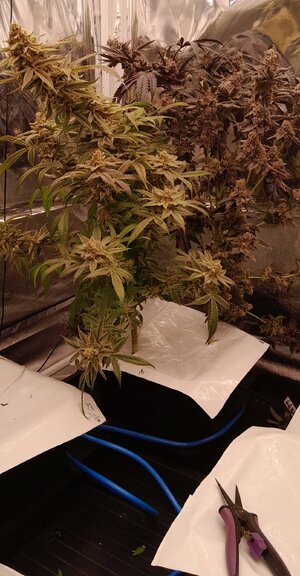
Ime bigger root balls don't mean much in terms of yeild, some of the heavier plants I've grown were vegged and sexed in a handful of coco then re potted to flower.
Re potting to flower, its been sexed.
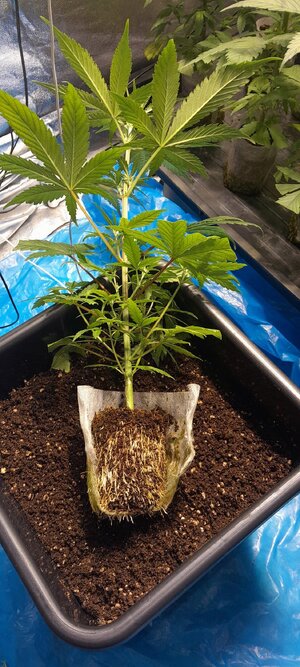
iirc 55 days later

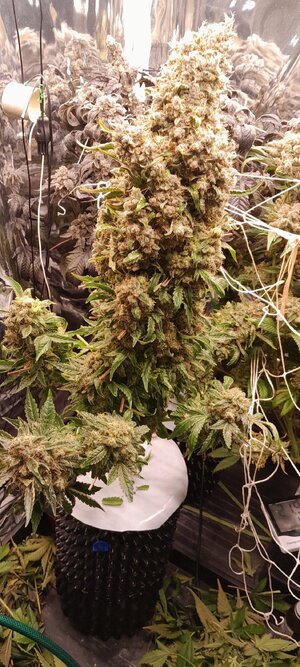
Some clones put into 12-12.
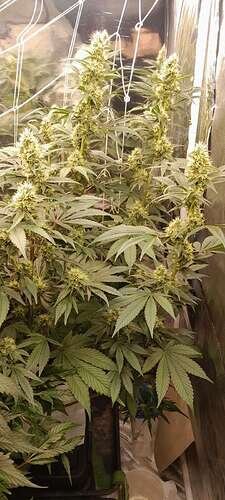
Fwiw imo plant health + genetics make the biggest bestest buds.

Ime bigger root balls don't mean much in terms of yeild, some of the heavier plants I've grown were vegged and sexed in a handful of coco then re potted to flower.
Re potting to flower, its been sexed.

iirc 55 days later


Some clones put into 12-12.

Fwiw imo plant health + genetics make the biggest bestest buds.
Observer
Quantum Yield Engineer
- Joined
- May 11, 2023
- Messages
- 6,006
- Reaction score
- 14,407
HahaDid you notice a growth spurt in her?
Observer
Quantum Yield Engineer
- Joined
- May 11, 2023
- Messages
- 6,006
- Reaction score
- 14,407
YupI've been growing 2 plants in a 8ltr autopot I'm happy with how they turn out.
View attachment 75916
Ime bigger root balls don't mean much in terms of yeild, some of the heavier plants I've grown were vegged and sexed in a handful of coco then re potted to flower.
Re potting to flower, its been sexed.
View attachment 75917
iirc 55 days later
View attachment 75918View attachment 75919
Some clones put into 12-12.
View attachment 75923
Fwiw imo plant health + genetics make the biggest bestest buds.
It's genetics and growth method, just "properly" growing a plant the "right" way and what "tricks" are used like Cropsteering methods and Environment variables manipulation, photoperiods and the seasons.
Besides a full and proper nutrient ratio, like manipulating hormones, adding silica, using kelp/PGRs.
Pot size isn't going to change that, just the way you work the variables.
I've grown a 5ft plant with a root zone system the size of a palm, or slightly smaller.
I bet I could get a thick 5foot cola with about the same root ball size too, from a solo, put 420 of them together in a 25 cubic foot space.
Bam
Rootsruler
Know it all
- Joined
- Apr 14, 2023
- Messages
- 3,273
- Reaction score
- 14,610
So the takeaway I'm seeing here is with fertigation a large root system is not necessary due to the frequent feeds?Yup
It's genetics and growth method, just "properly" growing a plant the "right" way and what "tricks" are used like Cropsteering methods and Environment variables manipulation, photoperiods and the seasons.
Besides a full and proper nutrient ratio, like manipulating hormones, adding silica, using kelp/PGRs.
Pot size isn't going to change that, just the way you work the variables.
I've grown a 5ft plant with a root zone system the size of a palm, or slightly smaller.
I bet I could get a thick 5foot cola with about the same root ball size too, from a solo, put 420 of them together in a 25 cubic foot space.
Bam
Doobie
Blaze Bandit
- Joined
- Jun 13, 2023
- Messages
- 90
- Reaction score
- 334
I have been reading alot of good things about the autopots. I looked for 1 gallon autopots but the smallest ones I found were 3 gallon versions. I always thought that bottom feeding coco was a no go. But with my current Grow I am learning to fertigate when needed and I have not had any issues so far. So I am not feeding until runoff every time. Once a day at most. So I bet if you top feed once a week until runoff in autopots you can have great success.I'm in Autopots now with Promix / Perlite 50/50 using GH trio + a few I have the 3.9 gal pots I split in half with dividers so each plant cell in less than 2 gal. I planted 12 in 6 pots 5 males so I now have 7 in 5 pots all thriving.
I don't do anything other than add nutes to the res. no PH ing anything I follow the GH recipe its so simple and the only problem is I grow myself out of space too fast. Once they start to feed they stretch and grow up into the lights, bending helps but they say fk you and grow back up.
I know Moe used them for a while but I don't know why he stopped, seems so simple maybe that's why, too easy for him.
Okay back to the question, depending on your system pot size means very little, I may try 1/4 Cells. now that I'm thinking about it.
Similar threads
- Replies
- 1
- Views
- 225
- Replies
- 5
- Views
- 183
- Replies
- 38
- Views
- 1K
- Replies
- 36
- Views
- 2K


